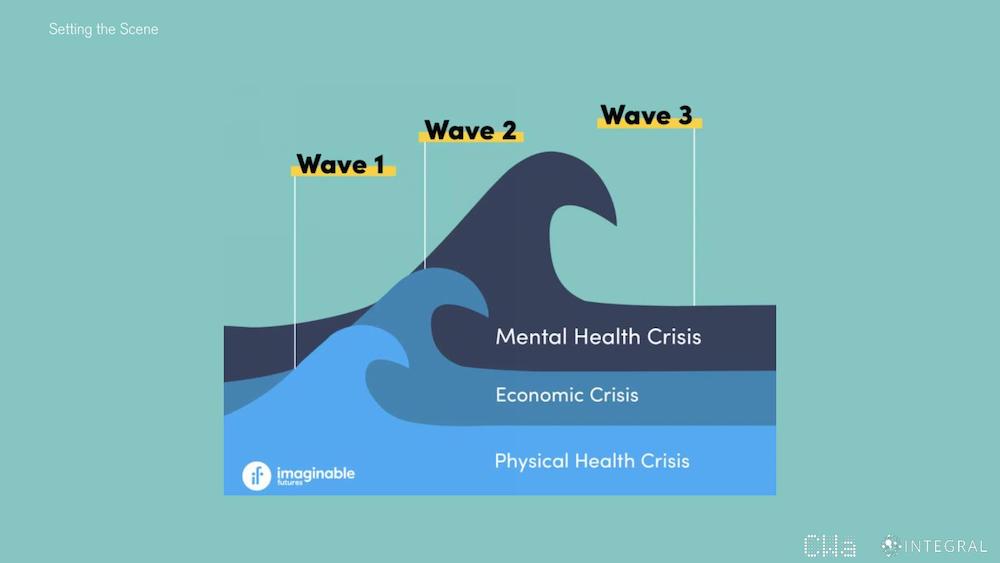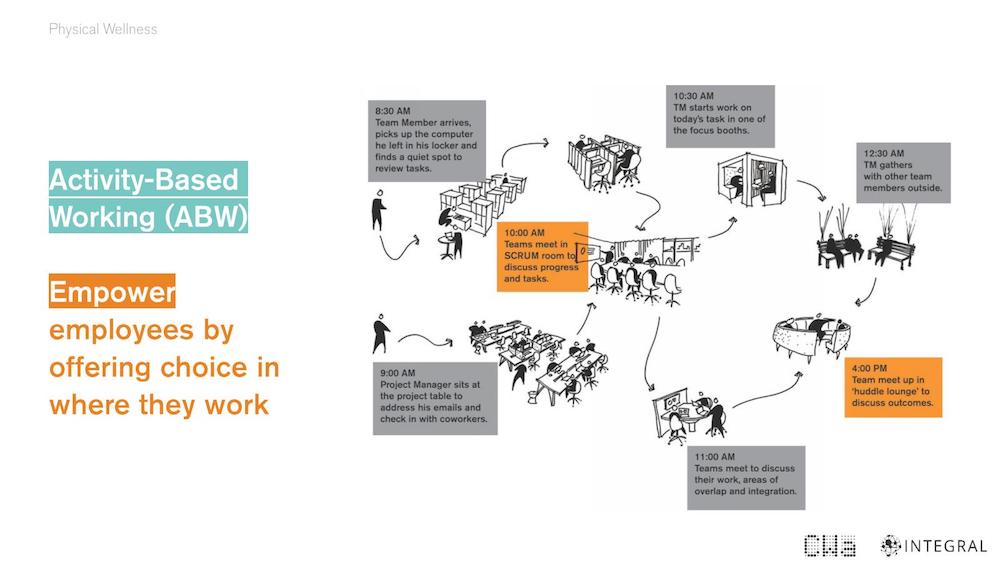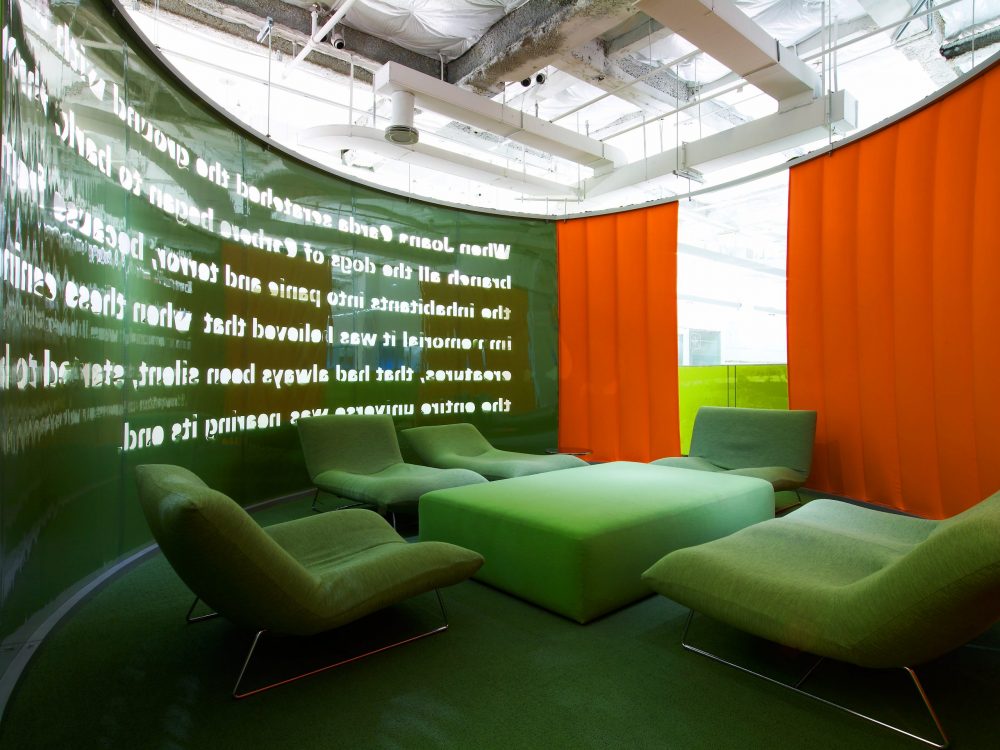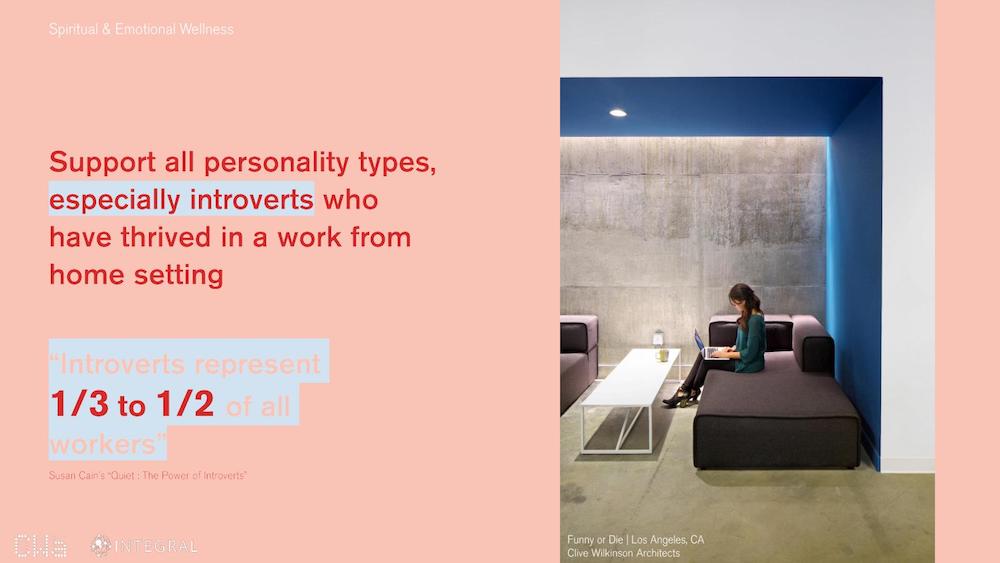NeoCon’s recent virtual program examines the way designers can approach new and continuing workplace projects with a refined emphasis on employee health and wellbeing.
WDM continues recapping a curated selection of theMart’s virtual programming that explore the many ways we can and should Design Anew. The program began in March and will continue through October, until we are able to connect again in Chicago on October 4th-6th. While we are looking forward to attending NeoCon in-person, the virtual programs have provided an avenue to keep up to date with the most pressing issues as we emerge from the pandemic and begin talking about the ways design will be a key element in determining the best ways to work and live going forward.
While the concept of designing for wellness is not new, its importance has been accelerated as the challenges of designing for the post pandemic workplace has created a new set of issues and concerns across the spectrum of the spaces we design. This program titled: “Bring Your Whole Self to Work: Designing for Holistic Employee Wellness,” examined the way designers can approach new and continuing workplace projects with a refined emphasis on employee health and wellbeing.
The program was presented by: Caroline Morris, Associate, Clive Wilkinson Architects; Amber Wernick, IIDA, Associate, Clive Wilkinson Architects; and Megan White, LEED AP+ (BD+C, ID+C, O+M), LFA, WELL AP, Fitwel Ambassador, Chief Sustainability Officer, Integral Group. They began with an outline of where we are with respect to our collective mental health and productivity, working remotely and connecting virtually. Some key points included:
- 74% of all workers, including 88 % of those ages 18-24, say poor mental health has impacted their productivity.¹
- 55% of employees would prefer to be remote at least three days a week, once pandemic concerns fade.²
- Studies have shown that there are myriad issues around inclusion and how employees present themselves at work that may differ from their true self.
- Having happy and healthy employees has proven to result in higher productivity and engagement and lower healthcare costs and turnover.

With these issues in mind and an overall perspective on how designers can positively impact behavior, the panel reviewed design strategies to support in-office and hybrid employee well-being in the workplace. The following questions were submitted by attendees:
How would you go about implementing activity-based working in an organization?
Amber Wernick: We spend a great deal of time and energy in research and visioning upfront to uncover the best workplace strategy for each organization. We often introduce activity-based working or ABW during the visioning phase and emphasize its positive effects on employee productivity and wellness. It offers a wide variety of work settings and empowers employees to choose where they work.
If ABW is the recommended strategy, then we continue to explore how people work. What’s so brilliant about ABW is that it’s highly tailored not just to each organization but to each department. We begin by identifying the unique work tasks or activities as well as the frequency or importance of those activities. This can be accomplished with interviews, surveys, ‘day in the life’ schedules, occupancy sensors, and shadowing. Once we deeply understand how people work, we can intentionally design a ‘kit of parts’ or work settings to support them. The ratios and configurations of the ‘kit of parts’ typically varies from department to department, but the overall framework is designed to be flexible and adaptive to evolving organizational needs.

We are also involved in change management to ensure the successful adoption of new workplace strategies like ABW. The idea is that employees who feel they have been included in the discussion and who understand the rationale will support and adapt to change. Some examples of change management initiatives include pilot spaces to test the ‘kit of parts’ and workplace manuals to describe how best to utilize the new environment.
In a hybrid workspace, how do you encourage people to go into the office if they have the option to work from home?
Caroline Morris: We think many people will actually want to return to the office on their own. The office offers benefits that the home does not. And on the other hand, the home offers benefits that the office does not, which is one of the reasons why a hybrid model is appealing. We see three main drivers that will bring people back to the office – collaboration, serendipitous encounters and connection to community and culture – let’s look at each.
Certain types of collaboration can be challenging when not in the office – particularly brainstorming and ideation work that require creative or strategic thinking. We’re seeing people return to the office to do functions they cannot remotely, whether that be reviewing physical products, whiteboarding, pinning up or other tasks that are tactile in nature.
Serendipitous encounters are nonexistent while working remotely. And we know that cross-functional knowledge sharing is suffering because of this. These serendipitous encounters aren’t only a social benefit, but they also drive tacit knowledge sharing. According to research by Cushman & Wakefield, over a third of employees engaged in remote work during the pandemic do not feel like they are learning. Formal process learning is continuing but informal learning and mentoring are challenged.

Lastly, we cannot underestimate the value of our connections to community and culture, especially after being apart for so long. Studies show that a sense of belonging to a greater community improves your motivation, health, and happiness. People want to be connected to a shared purpose or company mission. For many, the isolation of the pandemic was even more challenging because their work communities were missing. These types of interactions simply cannot be replicated virtually.

Do you find that your clients are advocating for these strategies also?
Amber Wernick: Yes, many times there’s an awareness of and sensitivity about employee wellness. When it’s not on their radar, then we introduce them to these strategies during visioning to gauge their interest. It’s important for our clients to understand that enhancing employee wellness will ultimately lead to organizational success. When employees are supported, they bring the best versions of themselves to the table. And when employees thrive, business thrives – it’s a win, win.

As designers, when do we start the conversation with clients about these dimensions of wellness?
Megan White: From the very start. We introduce the wellness wheel in the very first kickoff meeting as part of our education series. I think it’s helpful to introduce many different frameworks in a charrette style workshop so that you can gauge the stakeholders on what resonates most with them. Some clients gravitate towards the wellness wheel, others will want a specific certification like the WELL Building Standard or Fitwel for example.
Thank you for talking about introvert/extrovert and how people feel towards their space pending this personality type. I am wondering if this idea of “choice” seating may cause some stress or anxiety for people who may want to have their dedicated working location but find it is rarely available or more populated than assigned seating? Or, if they are worried of not being seen/heard from leadership?
Amber Wernick: Long before the pandemic, we saw flaws in the one-size-fits-all office. This is because employees have a vast range of needs that can vary by location, department, role, seniority, and even personality type. Offering variety and choice in the work environment supports variety in the workforce itself.
Concerns about seat availability and access to leadership can be addressed with neighborhood planning and space utilization technology. Anchors or resident workers who are in the office full-time and engage in primarily individual activities can have assigned seating. Connectors or hybrid employees who are in the office part-time and move frequently between individual and group activities can be assigned to neighborhoods or zones within the workplace. There are apps designed to see what seats are available, reserve seats in advance, and even find colleagues if they “check in” to a neighborhood.

WDM: Big picture, what are the most significant ways you see the office changing post-pandemic?
Caroline Morris: Big question – it’s going to be different for every industry and organization, but with that said, we are seeing a hybrid model emerging. With that model, workers will use the office differently than they did pre-pandemic when they were in-office 100% of the time. Naturally, the office will need to transition to support new ways of working in return. It’s important to understand who is going to use the office and what types of work need to happen there to design the environment properly.
Our team at Clive Wilkinson Architects has written an article series “The 12 Building Blocks of the New Workplace” that describes the three different types of workers – Anchors, Connectors and Navigators – ranging from more in-office to less-in office. The percentage of each type of worker within an organization will drive the ratios of individual, collaboration, specialized and support spaces. We often find that companies have three types of employees: Anchors, Connectors and Navigators.3 Anchors are resident office workers. They are very autonomous and rarely leave their personal work settings or immediate surroundings. Anchors may be fixed to a certain location and may require access to in-office resources like paper files. Connectors have a hybrid work schedule, spending part of their time remote and part in-office. Many employees have proven they can be productive remotely, and we believe that the hybrid work model will become more commonplace than ever before. Connectors come into the office regularly for specific tasks that can’t be done (or can’t be done as well) remotely. They are mobile while in the office, moving around to different spaces based on the task at hand. Navigators are highly mobile, and their work can be done anywhere. Navigators rarely use the office, accessing it to exchange information and attend meetings. They come to the workplace as needed, which could be a few days per month for a strategic brainstorming session or an all-hands event.

Since these worker types interact with the office in different ways, there are distinct combinations of the New Workplace Kit of Parts that support them best. For example, an administrative team may have mostly in-office resident workers or Anchors so they will have more “cool” spaces to support their independent, individual work. On the other hand, a sales team may have more remote workers or Navigators so they will have more “hot” spaces to support collaboration and community-building when they come to the office. Ultimately, every organization will have their own unique mix of these three worker types, which will create a far more varied work environment post-pandemic.

WDM: While we have been designing with sustainability issues in mind for a while, we are now seeing the closer relationship between physical environment and health and wellness. There is especially more interest in designing for health and wellbeing across all project types with a focus on mental health issues. As some of the attendee questions allude, is this something designers need to bring to the client more emphatically or are they seeking more holistic solutions?
Megan White: I think this is a fully accurate synopsis of how we have been seeing the market shift in recent years. However, sustainability as we knew it (I.e. LEED certification, energy efficiency) is also taking a radical turn towards a focus on carbon (operational and embodied) and going all-electric. The beauty in this transition toward a carbon-conscious design is that it typically is a win-win with respect to health: low embodied carbon structures which embrace ethically sourced mass timber structures tend to expose the natural material which is a biophilic design principal that supports connection to nature which in turn support mental health; and all-electric designs (no more direct fossil fuel sources) supports better air quality, especially if gas cooking is eliminated.
Furthermore, to your point, sustainability has felt too far removed for some to buy into it, where as a focus on health/wellness feels direct and has gotten more traction. One of the points which I hope we can start to understand though is that if our outdoor air quality continues to be poisoned by burning of fossil fuels for energy and increased fires due to the climate crisis, our health and wellbeing are going to be negatively affected. If we continue to poison our water ways, this is the water which we drink and the water that irrigates our food sources, which all become our bodies. We are nature, we are not separate from it. Our health and wellbeing are linked to the way we treat the planet.
Where can we get a copy of The Red List?
Megan White: The Red List is created by the International Living Futures Institute – you can learn more about it here.
For home environments where there is no backyard or restrictions to composting, what alternate methods of composting are available?
Megan White: Great question. Unfortunately, there are some limitations to composting. If a town/ city/ municipality does not offer a compost program (curbside pickup), and you don’t have a backyard, composting is a bit limited. We were doing a small-scale worm compost bin in our Oakland Office and it was successful, and with zero odors. This process produces a great compost juice-concentrate which can be used for fertilizing indoor plants.
We strongly recommend taking a break and watching the video of the presentation. There were some great suggestions and food for thought that will be helpful as we navigate to more thoughtful and healthy workplaces that employees will increasingly expect as they return to the office.
Connect with Clive Wilkinson Architects:
LinkedIn | Instagram | Twitter | YouTube | Behance
Connect with Integral Group:
LinkedIn | Instagram | Twitter
Footnotes:
¹ Aetna International 2020 Employee Health Study
² PwC (2021 January 12 Remote Work Study
3 Greene, Catherine. (2011, Feb). Space for thought: Designing for knowledge workers. Royal College of Arts.
This article is supported by the following 2021 NeoCon Exhibitors:




